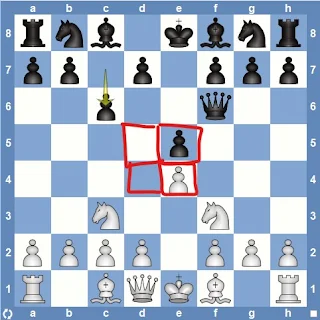
Chess is a recreational and competitive board game played between two players. The current form of the game emerged in Southern Europe during the second half of the 15th century after evolving from similar, much older games of Indian and Persian origin. Today, chess is one of the world's most popular games, played by millions of people worldwide at home, in clubs, online, by correspondence, and in tournaments.
The game is played on a square chequered chessboard with 64 squares arranged in an eight-by-eight grid. At the start, each player (one controlling the white pieces, the other controlling the black pieces) controls sixteen pieces: one king, one queen, two rooks, two knights, two bishops, and eight pawns. The object of the game is to checkmate the opponent's king, whereby the king is under immediate attack (in "check") and there is no way to remove it from attack on the next move.

The tradition of organized competitive chess started in the 16th century and has developed extensively. Chess today is a recognized sport of the International Olympic Committee. The first official World Chess Champion, Wilhelm Steinitz, claimed his title in 1886; Viswanathan Anand is the current World Champion.
Chess is commonly believed to have originated in India during the Gupta empire, where its early form in the 6th century was known as catura?ga, which translates as "four divisions [of the military]" – infantry, cavalry, elephants, and chariotry, represented by the pieces that would evolve into the modern pawn, knight, bishop, and rook, respectively. Both the Persians and Arabs attribute the game of chess to the Indians. In Sassanid Persia around 600 the name became shatranj and the rules were developed further. Shatranj was taken up by the Muslim world after the Islamic conquest of Persia, with the pieces largely retaining their Persian names. In Spanish "shatranj" was rendered as ajedrez, in Portuguese as xadrez, and in Greek as zatrikion, but in the rest of Europe it was replaced by versions of the Persian shah ("king"), which was familiar as an exclamation and became our words "check and chess". Murray theorized that this change happened from Muslim traders coming to European seaports with ornamental chess kings as curios before they brought the game of chess.
The game reached Western Europe and Russia by at least three routes, the earliest being in the 9th century. By the year 1000 it had spread throughout Europe. Introduced into the Iberian Peninsula by the Moors in the 10th century, it was described in a famous 13th-century manuscript covering shatranj, backgammon, and dice named the Libro de los juegos.
Another theory contends that chess arose from the game xiangqi (Chinese Chess) or one of its predecessors. Around 1200, rules of shatranj started to be modified in southern Europe, and around 1475, several major changes made the game essentially as it is known today. These modern rules for the basic moves had been adopted in Italy and Spain. Pawns gained the option of advancing two squares on their first move, while bishops and queens acquired their modern abilities. The queen replaced the earlier vizier chess piece towards the end of the 10th century and by the 15th century, had become the most powerful piece; consequently modern chess was referred to as "Queen's Chess" or "Mad Queen Chess". These new rules quickly spread throughout western Europe, with the exception of the rules about stalemate, which were finalized in the early 19th century. To distinguish it from its predecessors, this version of the rules is sometimes referred to as western chess or international chess.
Writings about the theory of how to play chess began to appear in the 15th century. The oldest surviving printed chess book, Repetición de Amores y Arte de Ajedrez (Repetition of Love and the Art of Playing Chess) by Spanish churchman Luis Ramirez de Lucena was published in Salamanca in 1497. Lucena and later masters like Portuguese Pedro Damiano, Italians Giovanni Leonardo Di Bona, Giulio Cesare Polerio and Gioachino Greco or Spanish bishop Ruy López de Segura developed elements of openings and started to analyze simple endgames.

In the 18th century the center of European chess life moved from the Southern European countries to France. The two most important French masters were François-André Danican Philidor, a musician by profession, who discovered the importance of pawns for chess strategy, and later Louis-Charles Mahé de La Bourdonnais who won a famous series of matches with the Irish master Alexander McDonnell in 1834. Centers of chess life in this period were coffee houses in big European cities like Café de la Régence in Paris and Simpson's Divan in London.
As the 19th century progressed, chess organization developed quickly. Many chess clubs, chess books and chess journals appeared. There were correspondence matches between cities; for example the London Chess Club played against the Edinburgh Chess Club in 1824. Chess problems became a regular part of 19th-century newspapers; Bernhard Horwitz, Josef Kling and Samuel Loyd composed some of the most influential problems. In 1843, von der Lasa published his and Bilguer's Handbuch des Schachspiels (Handbook of Chess), the first comprehensive manual of chess theory.






